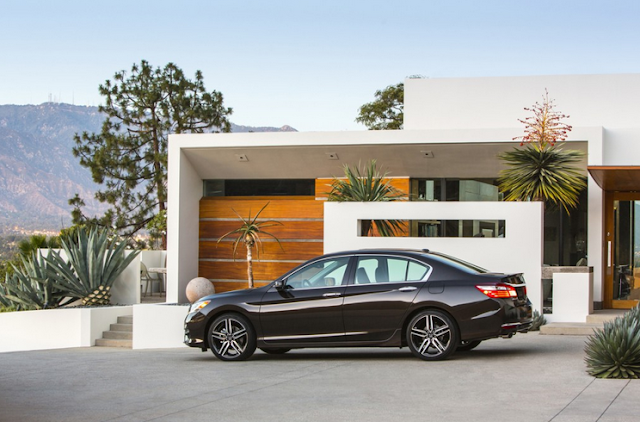Subsequent an inquiry we don't ask ourselves all the time: Is more power better? Yet that is something we contemplated amid in dispatch of the all new, tenth era Honda Civic, at which we drove both the new base 2.0-liter motor and the all the more intense 1.5-liter turbocharged four. Toward the day's end, there was no obvious answer as to which form is best. What was liberally clear, in any case, is that the base motor isn't terrible.
Nor is whatever remains of the 2016 Civic, however we'll get to that. The all-new 2.0-liter motor is offered just in the section level LX model and in the 1 rung-up EX. It is said by Honda to both weigh less and have lessened inner grinding contrasted and a year ago's 1.8-liter, while kicking out an extra 15 drive and 9 lb-ft of torque. The sums are presently 158 drive at 6500 rpm & 138 lb-ft at 4200 rpm. the genuine Honda i-VTEC designs, power fabricates in a straight crescendo, with no unevenness our slack. Pretty much a sweet is the 2.0-liter's rorty Honda sound—that is immaculate sound, without integrating or intensifications—which penetrates the Civic's all around protected lodge with each maximum capacity keep running up to the motor's 6700-rpm redl
 |
What's more, rev it hard we did, since it's none too speedy—anticipate that a zero-will 60-mph time in the low-eight-second range. We just timed the turbocharged 2016 Civic at 6.8 seconds to 60, with its 174 strength and 162 lb-ft of torque. The 2.0-liter likewise has an old-school Honda charm that the 1.5-liter's standard CVT programmed dulls a bit; if character numbers, the 2.0-liter puts forth a defense for itself.
There's Still a Stick
The other motivation to regard the base Civic is that it offers a manual transmission (like a year ago, however, it's limited to the cost driving LX). Honda agents have let us know that we can expect more Civics—including the 1.5-liter turbo—to offer a stick shift later on, however that improvement assets until further notice are centered around drawing out the other Civic variations yet to show up, including the roadster, the four-entryway hatchback, the Si, and the Type R. While the new six-velocity gearbox doesn't feel entirely as sweet as the one in the 2016 Accord Sport, it's a long way from messy, with unmistakably characterized doors and short tosses, and it's combined with a pleasantly dynamic grasp.
It surely beats the CVT, which is discretionary on the LX and standard on EX models or more. The absence of any type of manual proportion choice—by means of oars, movement lever, or something else—appears a touch of an oversight on Honda's part, in spite of the fact that a Sport mode keeps the motor buzzing closer to its energy crest in case you're feeling playful. (What's more, no, it's not the same CVT that has as of late been reviewed in the 2014 and 2015 Civic and Fit.)
Like different Civics, the base model turns in rapidly and pivots with chivalrously minimal front-end push, albeit the majority of the models we drove would profit by more tire hold. Other than 16-inch haggles/55-arrangement tires versus 17-inch wheels with 50-arrangement tires, there is little that isolates the undercarriage of 2.0-liter autos from their turbocharged brethren. They do measure about 150 pounds less, be that as it may, quite a bit of which falls off the front hub for fairly enhanced front-to-back weight dissemination (59.6/40.4 for the 2.0-liter contrasted and 61.3/38.7 for the 1.5-liter). The Civic 2.0 additionally has a reviving feeling of delicacy and sharpness, the slight dead spot in the controlling in
Creators, Arise!
With respect to whatever is left of the 2016 Civic, the upgrades can't be downplayed. Its configuration is smooth and fastback-like, with a huge, seriously raked nursery that no more incorporates sloppy front quarter-windows. The front bumpers highlight swells over the wheel curves, and the body general has a lot of chiseling. The back three-quarter perspective is the most unmistakable, inferable from the standard C-formed LED taillamps, decreasing windows, and depressed backdrop illumination. This is a very styled vehicles. Following quite a while of lethargic feel from Honda, we can now consider the automaker's configuration group to be completely conscious.
The lodge environs appear to be all the while more present day and more close, because of the wide dashboard plan, one-inch-lower front hip point, and taller two-layered focus reassure that indulge the front travelers. An old Honda characteristic has returned as the surprisingly low windshield cowl, which has dropped 1.6 creeps and permits a far reaching perspective of the street ahead.
Urban estimating begins at $19,475 for the LX and $21,875 to improve things prepared EX, with costs for the turbo models ascending from that point. In any case, even at the LX level, the Civic is no stripper, with its standard computerized speedometer, programmed atmosphere control, agreeable fabric seats, electronic stopping brake, programmed headlamps, and that's just the beginning. Settling on the EX yields a full computerized dashboard, Honda's clever LaneWatch camera framework, remote motor beginning, a force sunroof, warmed mirrors, Apple CarPlay/Android Auto, compound wheels (versus steelies with wheel covers), and the previously stated CVT. The EX likewise brings Honda's irritating level board "Show Audio" framework that asks for a volume handle; thankfully, the Civic's new guiding wheel-mounted sound controls minimize the utilization of said touch screen.
We offer more sentiments about the Civic's newly discovered goodness (and some of its weaknesses) in our instrumented test of the big cheese Touring model, which accompanies numerous more devices and thingamabobs, and in addition the 1.5-liter turbocharged motor. Whether that motor is the more alluring of the two is questionable, yet our positive involvement with the 2.0-liter models proposes that Honda has at the end of the day taken up the reason for building essential transportation that doesn't feel fundamental.








